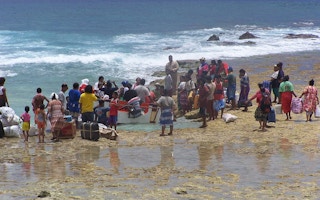Tuvalu, the world’s smallest sovereign country, started recreating itself in the metaverse to become the world’s first digital nation in 2022.
It was a move that can only be read as sincere desperation as it races to preserve its culture and identity in the digital world as climate change threatens to wipe the country off the physical world.
In the communications it submitted to the United Nations Framework convention on Climate Change (UNFCCC), Tuvalu declared that coastal erosion is an occurring problem and for some families, lands have already been consequently lost.
It is only one of many small island developing states (SIDS) in Asia and the Pacific facing extreme environmental vulnerabilities and climate catastrophe.
Factors like slow onset sea level rise causing coastal erosion already threaten livelihoods and property, and still the loss of territory from low elevation conditions is not the only concern for SIDS: infrastructure, food and water sources are also at risk, even as extreme weather events like tropical cyclones and storm surges directly threaten lives.
“
Every extremely hot day is a threat and assault on one’s health potentially causing death.
Thus, a new treaty announced in November 2023 granting climate change visas to citizens of Tuvalu by the government of Australia was a celebrated new development.
The Australia-Tuvalu Falepili Union treaty offers 280 Tuvaluans—2.5 per cent of the islands’ population—permanent residency in Australia each year according to details revealed by the Center for Global Development.
Tuvalu climate migrants will gain access to Australian education, health, and key income and family support upon arrival, yielding to the essence of the treaty’s first article on Purpose with the specific wording of ‘human mobility with dignity’.
Come to think of it, climate vulnerability is violence
When it comes to cross-border migration, climate and environmental impacts are omitted as reasons to seek protection and asylum under the Refugee convention of 1951 and its amendment in the 1967 protocol. Neither is climate change included among international migration drivers such as labour, family reunion and education as official conditions allowing states to grant entry visas and residency permits.
While the Australia-Tuvalu Falepili Union treaty is groundbreaking in legalising the status of “international climate migrant” it is so far the only one of its kind, and the formal bilateral recognition of ‘climate migration’ is limited to just that—between two countries.
For Tuvalu and other highly climate-vulnerable low-income countries in the world, given current understandings of anthropogenic climate change, environmental impacts and climate hazards are in fact a kind of violence.
Every extremely hot day is a threat and assault on one’s health potentially causing death via heat stroke or at the minimum, heat stress sending a person into illness for days at a time in an economy mired in poverty, without proper social healthcare systems in place.
And that every typhoon warning is anticipation of impending suffering akin to war in the form of wide-scale destruction of homes and other infrastructure preventing service systems like transport and energy from supporting entire cities and communities, cutting supply of precious resources like food, drinking water and electricity.
Migration scholars like Hein de Haas in the book Age of Migration discuss migration aspirations as a function of people’s general life aspirations and perceived geographical opportunity structures. If people have broader life aspirations that cannot be fulfilled at home, this often generates aspirations to migrate, according to De Haas and co-authors.
For a moment, let’s forget raising material aspirations; what if one’s aspiration is essentially, back to the basics of ensuring one’s own survival or that of his and her family and loved ones? But that this can no longer be fulfilled in the home, nor the community, nor the country where one is a citizen of because of the violence of climate vulnerability within the context of an underdeveloped economy.
And perhaps more importantly, how do we reckon that those who suffer the most from climate impacts contributed to climate change the least—how do we address climate justice?
Does climate lead to mass migration? Short answer: No
Those of you, who like me closely follow the discourse on climate justice, welcome the argument in favour of fast-tracking climate action in order not to have to deal with droves of people from the global south migrating to the global north.
Often, when poor people from underdeveloped countries having little to do with historical emissions want to seek refuge in wealthier industrialised economies often with the highest historical and current emissions exacerbating climate impacts, it’s understandable from a justice perspective. And it signals an image of upheaval: people moving en masse.
But counterintuitive as it may sound, there is no mass climate migration. And research evidence is disproving that climate change will lead to it. This is because migration is a multi-causal phenomenon driven by powerful economic, political, and social processes and is therefore difficult to attribute directly to environmental factors.
The work of De Haas and colleagues shows evidence that environmental degradation and disasters need to go hand in hand with political instability, poverty, violent conflict, and corruption to create conditions for large-scale displacement—they argue that the most vulnerable are often deprived of capabilities to move and thus, remain.
And yet accelerated climate impacts are anticipated by every climate science reporting in the last few decades, including the most prominent from the Intergovernmental Panel on Climate Change (IPCC). And development institutions the world over are acknowledging the occurrence of climate displacement.
The World Bank in its seminal Groundswell report of 2021 declares that “climate change could force 216 million people across six world regions to move within their countries by 2050.”
Government bodies like the European Parliament are attempting to define “climate refugee” and in a 2023 Briefing Note declares that “over 376 million people have been displaced because of natural disasters brought about by climate change since 2008, with 36.2 million people displaced in 2022 alone.”
The EU proceeds to state that while many found refuge within their own countries, some were forced to go abroad.
Following the capabilities argument, upheaval and mass cross-border migration may never happen, but catastrophic suffering is expected. In this vein, the governments of the world have the chance to plan migration of the most vulnerable peoples in a way that adheres to the principle of ‘mobility with dignity’ exemplified by the Falepeli Union, with benefits for receiving countries.
Planned migration as climate pledge
At the recent UN climate conference COP28 in Dubai in December 2023 came the announcement of a Loss and Damage fund which would help compensate vulnerable countries coping with loss and damage caused by climate change
While a breakthrough for climate justice, operationalisation of the fund remains a challenge with only a handful of countries committing financial pledges. And especially in consideration of how an earlier commitment funding for climate adaptation and mitigation announced 13 years ago in Copenhagen via the Green Climate Fund similarly remains under-pledged, global climate governance must therefore consider other possibilities.
What if planned migration strategies for climate vulnerable countries with low historical emissions like Tuvalu, as demonstrated by efforts like the Falepeli Union, are marked as both climate adaptation and loss and damage activities in global climate politics?
The recognition of climate as a migration driver and migration as a climate risk mitigation and adaptation strategy can prove beneficial to both receiving-global north and sending-global south countries in many ways.
In the case of high-income industrialised economies with aging populations, receiving climate migrants can cover for labour shortage while fulfilling international commitments to climate adaptation and loss and damage pledges.
In the case of climate vulnerable low-income countries with high migration aspirations but low capabilities, an international pathway in climate migration will allow decent and dignified futures for themselves and their families.
If done in an orderly manner, a planned migration strategy in the true sense of the words, can be win-win for country parties to the UN Climate convention and just might illuminate a clearer path for the world towards a just and equitable climate-safe future for all.
Philline van der Wolk-Donggay is a sustainable development consultant and climate solutions entrepreneur. She co-founded Greenergy Development, an energy transition company in the Philippines and is working on sustainability communications projects including one funded by the European Climate Foundation.
Acknowledgements to Michiel de Haas who lectures on Global Migration at Wageningen University and Research.











